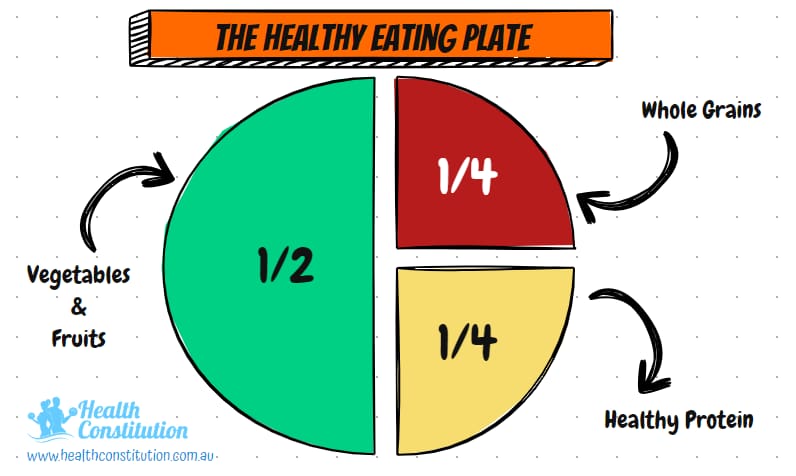As a person who is always fascinated by the power of mindful eating, my journey towards a balanced diet began with a desire to improve my overall health and well-being. Through mindful eating and the guidance of the Healthy Eating Plate, I’ve discovered a deeper connection with food and a newfound appreciation for its ability to nourish my body and mind.
Keep reading if you are looking to transform your relationship with food and fuel your body with the nutrients it craves!
What is Mindful Eating?
Mindful eating is the practice of paying close attention to your physical and emotional sensations while eating [1]. It involves slowing down, savouring each bite, and being present in the moment. This isn’t about strict dieting or deprivation, but rather about developing a deeper understanding of your body’s needs and responding to them with care and compassion.
The Power of the Healthy Eating Plate
Created by Harvard University, the Healthy Eating Plate is a visual guide that helps you create balanced meals [2]. It divides your plate into three sections:
- Half your plate: Filled with non-starchy vegetables and fruits like leafy greens, broccoli, carrots, and bell peppers, providing essential vitamins, minerals, and fibre.
- One-quarter of your plate: Filled with whole grains like brown rice, quinoa, whole-wheat bread, or oats, offering sustained energy and rich in fibre.
- One-quarter of your plate: Filled with lean protein sources like fish, poultry, beans, lentils, or tofu, helping build and repair tissues and maintain a healthy metabolism.
The Healthy Eating Plate also encourages incorporating healthy fats, such as those found in nuts, seeds, avocados, and olive oil, in moderation.

Simple Steps for Mindful Eating
Embracing mindful eating can be surprisingly simple. Here are some steps to get you started:
- Plan and prepare meals in advance: This prevents unhealthy temptations when short on time.
- Eat slowly and savour your food: Pay attention to taste, texture, and aroma with each bite.
- Avoid distractions: Turn off the TV, put away your phone, and focus on your meal.
- Listen to your body: Stop eating when satisfied, not stuffed.
- Drink plenty of water: Aids in feeling full and reduces cravings.
- Be mindful of your emotions: Don’t use food to cope with stress or boredom.
- Make healthy substitutions: Swap unhealthy ingredients for healthier alternatives.
- Be patient and kind to yourself: Learning takes time and practice.
Benefits of Mindful Eating and Simple Steps
Being mindful when eating and following the Healthy Eating Plate guide can lead to a multitude of benefits, including:
- Improved health and well-being: A balanced diet rich in essential nutrients strengthens immunity, prevents disease, and promotes longevity.
- Boosted energy levels and cognitive function: Nutrient-rich meals provide sustained energy, improving focus, concentration, and productivity.
- Enhanced mood and reduced stress: Mindful eating helps manage stress and improve overall mood by promoting self-awareness and reducing negative emotions associated with unhealthy eating habits.
- Effective weight management and healthy body composition: Tuning into your body’s hunger and fullness cues naturally regulates calorie intake and promotes a healthy weight.
Eating mindfully can offer a powerful and accessible approach to nourishing your body and mind. By implementing these steps into your daily life, you can unlock a range of benefits, including improved health, increased energy, and enhanced well-being.
Mindful eating is a journey, not a destination so start small, be patient with yourself, and enjoy the process of connecting with your body and rediscovering the joy of eating.
FAQs About Mindful Eating
Mindful eating focuses on developing a deeper awareness of your body’s hunger and fullness cues, making conscious food choices, and enjoying the experience of eating. Dieting typically involves restricting calorie intake or adhering to specific food rules, often with the goal of weight loss. While mindful eating can contribute to weight management, it’s not primarily about restriction.
Overcoming common challenges with mindful eating requires awareness and proactive strategies. To combat distractions, practice in a calm environment free from technology and other interruptions. Pay close attention to your body’s signals, differentiating between genuine hunger and emotional or stress-induced cravings. Patience, practice, and self-compassion are key to overcoming challenges and reaping the benefits of a mindful relationship with food.
You can enjoy your favourite treats in moderation while still making conscious choices and prioritising your overall health. Mindful eating is about developing a balanced relationship with food, not eliminating certain foods.
The Healthy Eating Plate focuses on creating balanced meals rather than specific calorie counts or portion sizes. It emphasises the importance of non-starchy vegetables, whole grains, and lean protein while encouraging healthy fats in moderation. This approach is flexible and adaptable to individual dietary needs and preferences.
- Who Should (and Shouldn’t) Take Probiotics? - 16 November 2024
- How to Choose the Right Probiotic - 16 November 2024
- Prebiotics vs Probiotics: The Dynamic Duo of Gut Health - 16 November 2024
